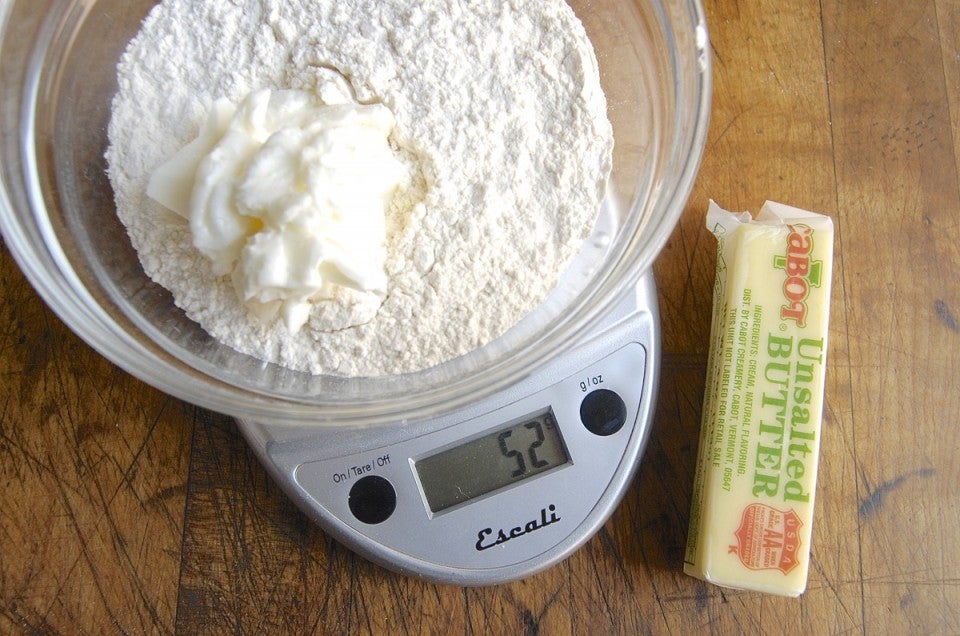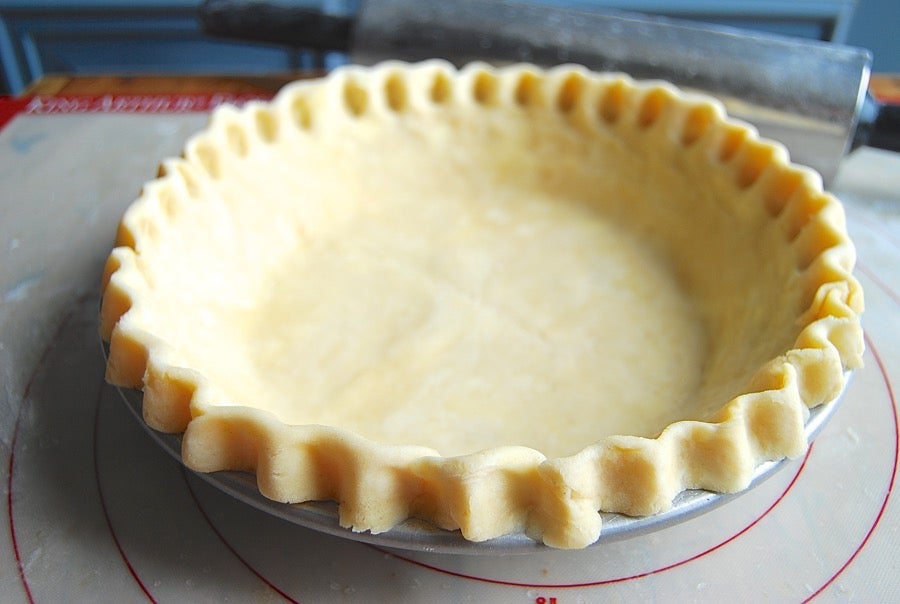


You know how sometimes you're baking, and all of a sudden you feel the urge to say some very bad words?
Like when the pumpkin filling slops onto the floor as you juggle the pie on its way to the oven.
Or you set the timer for just 2 more minutes, to give those brownies a crisp edge – then go outside to get the mail, run into a neighbor, get chatting and, well... bad words are definitely said as the acrid smell of burned brownies fills the kitchen.
I have a pie crust recipe I've loved for years, but it's always been just a tad... too... small for my favorite pie pan. Many's the time I've said [bad words] while trying to roll the crust just a tiny bit larger – causing it, of course, to stick, tear, or both.
Some people like making delicate, thin pie crust; I prefer a more substantial crust, one that's A) easier to work with, and B) doesn't simply become inconsequential under its load of bubbling berries.
And this crust recipe – well, I could barely roll it wide enough for my 9" wide, 1 1/2"-deep pie pan...
...let alone make any kind of stand-up crimped edge. I mean, if you're going to make a crimped edge, MAKE one.
Then one day (as my 5th grade teacher Miss Kellam would have said), "Light dawns on Marblehead!"
Why not make the crust a bit bigger?
I don't need a new recipe; I love the crust. I just want more of it – not "double" more, just a little bit more.
The challenge: increase the size of the crust without changing the balance among its ingredients. I like the mix of butter and shortening, the "just enough" ice water that yields delicacy rather than cardboard-y hardness.
The solution: baker's percentage, a.k.a. baker's weights (or baker's math).
Percentages? Math? What does this have to do with flour and butter and a wonderfully flaky pie crust?
Lots, as you'll soon see.
Now, don't click out of here; I'm not going all math-y on you. This is simple, once you get the hang of it. And pretty soon you'll be making 17 muffins instead of 12, five biscuits instead of 15 – using just a couple of basic calculations.
Let's take a look at a typical pie crust recipe and see how this works.

This is the beginning of our Classic Single Pie Crust recipe. You'll notice I'm looking at the recipe not in volume, but in grams; baker's percentage is all based on weight, not volume, so you'll need a scale to try this at home.
And why grams? Grams are MUCH easier to calculate percentages with than ounces and fractions of ounces.
Flour is pegged at 100%, and everything else is viewed as a percentage of flour. In our pie crust recipe, flour weighs 177g.
To determine the percentage of the other ingredients, divide each one by the weight of the flour (177g), then multiply the result (which is in decimal form) by 100 to convert it to a percent:
• The shortening (46g) is 26% of the flour, by weight: (46 ÷ 177) x 100 = 26%
• The butter (71g) is 40% of the flour, by weight: (71÷ 177) x 100 = 40%
• The water (using the lesser amount, 43g) is 24% of the flour, by weight: (43 ÷ 177) x 100 = 24%
The original recipe calls for 1 1/2 cups of our unbleached all-purpose flour. Let's say I want to increase that amount to 1 2/3 cups flour; I think that little bit extra flour is just the cushion I need to make the size crust I want.
The weight of 1 2/3 cups of flour is 201g (as calculated from our online ingredient weight chart, a super resource when you're measuring by weight). Let's see what the increased weights of the rest of our ingredients will be:
Now, that's not so hard, is it?
But what about the salt, you say? Since it's such a small percentage of the flour weight, I tend to salt to taste; I'd increase the salt by maybe 1/8 teaspoon, or a big pinch.
And what happens when a recipe you're making includes eggs – which aren't measured by volume at all, but by units? Well, a large egg weighs about 50g out of its shell – so take it from there.
Once you stop thinking in units or volume, and start thinking (and measuring) in grams, scaling recipes up and down becomes quite simple.
And the results quite sublime!
Note: For a more detailed explanation, check out baker's percentage on our professional site.








June 28, 2024 at 3:20pm
Reducing loaves.
I'm suffering over here. I'm starting with your "easiest loaf you'll ever bake" recipe, but it makes too much for lil ole me and my wife, and I end up throwing away the second loaf. Obviously, I guess I could divide and freeze before baking... but I'm trying to make just one loaf. Pretty much on track for "baker's percentage" - but it's the little stuff. 1 Tbsp sugar ... 2.25tsp yeast, 2.5tsp salt... convert to grams, carry the one, divide by flour volume.... Based on 540g of flour in the full recipe, I end up with 15g, 12g, 13g respectively - each about 3% compared to the flour. I ended up trying to measure 8g of sugar, salt, and yeast. That's nuts. My scale barely registers the change.
Suggestions? Just go with halving the measuring spoons?
June 30, 2024 at 11:16am
In reply to Reducing loaves. I'm… by scott (not verified)
Hi Scott! We are sorry to hear of the troubles here...and have a few tips that may help. When it comes to smaller measurements, sometimes using the volume amounts is going to be simpler (especially since not all scales are best suited for measuring out those small gram amounts). For this recipe, you could use 1 1/8 teaspoons yeast, 1 1/4 teaspoons salt and 1 1/2 teaspoons sugar (dividing the original amounts in half since you are only making one loaf). If, however, you do want use the weight measurements, you certainly can. We would recommend investing in a precision scale for that, such as this one. Those are specifically designed to measure more accurately at those smaller levels.
June 30, 2024 at 12:31pm
In reply to Hi Scott! We are sorry to… by rsalerno
Thank you!
November 21, 2022 at 11:29am
If scaling a recipe with yeast in it , does the yeast scale the same way as well? I doubled a recipe and doubled the yeast but it seemed like my dough was going crazy!
November 27, 2022 at 11:07am
In reply to If scaling a recipe with… by Janice (not verified)
Hi Janice, if your double a bread recipe you can also double the amount of yeast because the overall ingredients should remain in proportion to one another. However, often recipes include a little more yeast than is necessary, so sometimes it will work to increase the yeast by a smaller percentage (say, 1.5X). If you have trouble keeping up with the increased amount of dough, increasing the yeast by a smaller percentage will tend to slow down the process a bit. Another option, if you find your dough is moving too fast or there's too much of it for you to handle in a timely manner, is to refrigerate a portion of the dough after the first rise. This can be especially helpful if you only have one loaf pan or are making more rolls than you can bake off at one time.
February 19, 2022 at 12:08pm
Perhaps this already has been addressed in the comments but if it has, I cannot find it. In short, I am way beyond confused. Using the pie crust recipe as an example again, the increase in grams of flour is 13.5% of the original weight. If I add 13.5% to the gram weight of all the other ingredients, it seems I derive exactly the same numbers that are derived in the blog post. If that is true -- and I'm pretty sure it is, as I've gone over it twice now with paper and pencil -- why would a person need to begin by calculating every ingredient as a percentage of the flour? Yikes, I can't for the life of me figure out what I'm missing!
February 23, 2022 at 5:48pm
In reply to Perhaps this already has… by Paul (not verified)
Hi Paul! I would love to be able to help you with this question, but I'm afraid I don't understand exactly what is being asked without more information. This sounds like a great time to call our free Baker's Hotline at 855-371-2253 for further assistance.
We think the best approach in answering your questions will be chatting with you directly rather than lots of emails back and forth. Our Baker’s Hotline is staffed Mon - Fri from 9am - 9pm and Sat - Sun from 9am - 5pm, EST. Looking forward to your call!
April 30, 2022 at 6:36pm
In reply to Perhaps this already has… by Paul (not verified)
Paul, you are correct. The above math is unnecessarily complicated. If you want to use 201 g of flour instead of 177 g, this means you will be using 201/177 = 1.135 times as much flour as the original recipe. So just multiply every other ingredient with 1.135 and voilà - you have the recipe for a thicker pie crust.
Happy baking!
May 1, 2022 at 10:31am
In reply to Paul, you are correct. The… by Tina (not verified)
Hi Tina and Paul, Baker's Math, and describing each of the ingredients as a percentage of the flour weight, makes sense to professional bread bakers in the same way that musical notes make sense to musicians. It's a way of expressing a bread formula that is clear and instantly communicates information about the type of bread being made. For example, when bakers see that the hydration percentage (the weight of the water as compared to the flour) is 80%, that's going to be a pretty wet dough, whereas a dough that is 60% hydration will be much stiffer. In the first case you may be making ciabatta, while the lower hydration recipe is more likely to be a sandwich bread or bagel. Creating a formula in this way also makes scaling a recipe up or down easier for professional bakers. But you are both totally correct that there is more than one way to skin a cat, and you can also adjust a recipe as you described. We always recommend doing what works best for you, so if this method doesn't make sense to you, then there's no reason you need to adopt it.
August 8, 2021 at 9:37pm
Hello, I know how to calculate Bakers percentage, but I would like to know if there is away to know how mucho of the other ingredients in a recipe I need to use only knowing that for example 500g of flour and that’s my 100%, so how much will I need for the rest of the ingredients
Thank you
Pagination